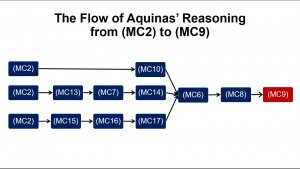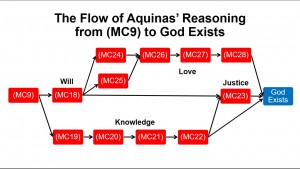Aquinas’ Argument for the Existence of God – Part 4
NOTE: I began to reconstruct Aquinas’ argument for the existence of God in the post I Don’t Care – Part 4, and continued that effort in I Don’t Care – Part 5, and I Don’t Care – Part 6. I am changing the title of this series to better reflect the content, so I consider the previous posts numbered as Parts 4, 5, and 6 to constitute Parts 1, 2, and 3 (respectively) of this new series called “Aquinas’ Argument for the Existence of God”. That is why I’m calling this post “Part 4”.
The first “half” of Aquinas’ argument for the existence of God can be summarized like this:
(MC2)–>(MC6)–>(MC9)
Here are the key metaphysical claims from that first part of his argument:
(MC2) There exists an FEC being. (FEC = First Efficient Cause)
(MC6) There exists an IES being. (IES = ipsum esse subsistens)
(MC9) There exists an IES being that is in the highest degree of immateriality and that has perfect knowledge.
There are arguments for each of these claims, and there are intermediate steps between each of these claims, so the actual argument is more complex and involves several other claims, including several other metaphysical claims. Click on the diagram below for a clearer image of a more detailed summary of this first “half” of Aquinas’ argument for God:
For more details on this first part of Aquinas’ argument, see the previous post in this series.
The second “half” of Aquinas’s argument can be summarized like this:
(MC9)–>(MC22)
(MC9)–>(MC23)
(MC9)–>(MC28)
Metaphysical claim (MC22) asserts there is an IES being who is omniscient (i.e. who knows all things by proper knowledge – See Summa Theologica PI, Q14, A6).
Metaphysical claim (MC23) asserts there is an IES being who is perfectly just (i.e. who always acts justly – See Summa Theologica PI, Q21, A1).
Metaphysical claim (MC28) asserts there is an IES being who is perfectly loving (i.e. who loves all things and who always loves the better things more – see Summa Theologica PI, Q20, A4).
There is a final step (or phase?) that goes from the conjunction of (MC22), (MC23), and (MC28) to the conclusion that God exists.
This final step requires that Aquinas either prove that there can be only one IES being, or else that there can be only one IES being that has these three properties. Also, Aquinas needs to show that other divine attributes belong to this being (i.e. omnipotence, bodilessness, and eternality). But for now, I have mapped out the flow of Aquinas’ reasoning from (MC9) to the conclusion that God exists, with focus on (MC22), (MC23), and (MC28):
Click on this image to get a clearer view of the diagram.
I have now completed a high-level flow of some important parts of Aquinas’ argument for the existence of God. I have skipped over many details of his specific arguments for each of the many metaphysical claims referenced in the above diagrams, and I have not yet attempted to determine the reasoning for other parts of the argument (concerning the divine attributes of being creator of the universe, a bodiless person, omnipotence, and eternality). I have also not yet attempted to figure out how Aquinas argues that there is only one being that possesses all of these various divine attributes, so the above diagrams leave out important and essential parts of Aquinas’ argument for the existence of God.
Note that the very first metaphysical claim (MC2) is the ONLY claim (out of the many metaphysical claims referenced in the above diagrams) that Aquinas argues for in the famous “Five Ways” passage.
It should be plainly obvious at this point that the “Five Ways” passage represents only the very beginning of a long and complex argument for the existence of God, and therefore the traditional view that Aquinas presents five arguments for the existence of God in the “Five Ways” passage is utterly and completely wrong, and is utterly and completely STUPID.
Aquinas does NOT give five arguments for the existence of God in just a couple of pages; rather, Aquinas gives ONE argument for the existence of God that takes up over one hundred pages of Summa Theologica (the material included in my diagrams starts near the beginning of Summa Theologica and goes up to Question 21, Article 1, which in my copy is on page 125), and that involves literally dozens of inferences and sub-arguments.
Here are the metaphysical claims referenced in the above diagram of the flow of reasoning from (MC9) to the conclusion that “God exists”:
(MC18) There is an IES being that has a will. (see Q19, A1)
(MC19) There is an IES being that understands itself. (see Q14, A2)
(MC20) There is an IES being who perfectly comprehends itself. (see Q14, A3)
(MC21) There is an IES being who knows all things. (see Q14, A5)
(MC22) There is an IES being who knows all things by proper knowledge. (see Q14, A6).
(MC23) There is an IES being who always acts justly. (see Q21, A1).
(MC24) There is an IES being in which love exists. (see Q20, A1)
(MC25) There is an IES being with a will that is the cause of things. (see Q19, A4)
(MC26) There is an IES being that loves all things. (see Q20, A2)
(MC27) There is an IES being that loves all things, but loves some things more than others. (see Q20, A3)
(MC28) There is an IES being who loves all things and who always loves the better things more. (see Q20, A4).


